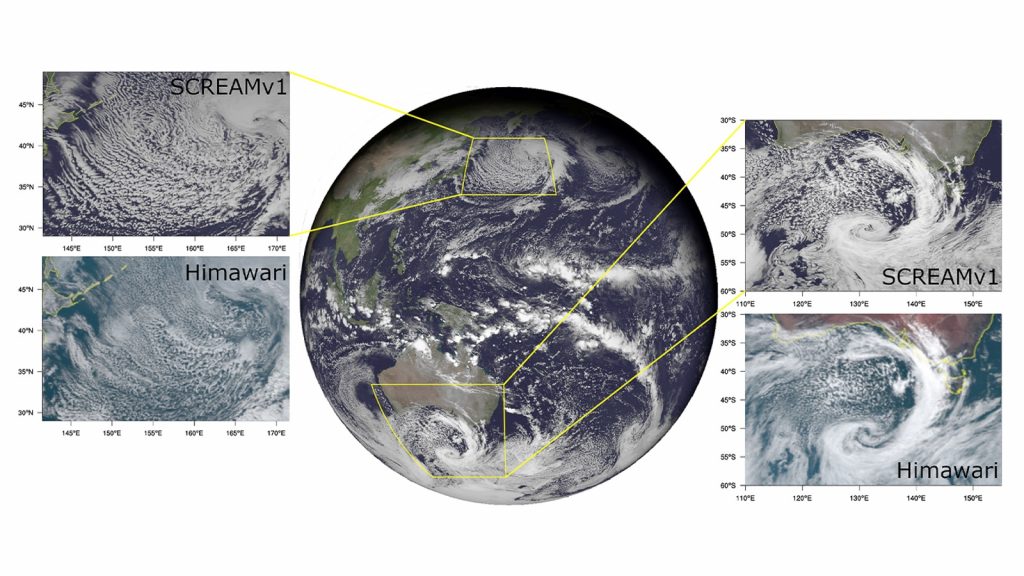Argonne scientists are part of two teams nominated for the prestigious computing award
Multi-lab teams use supercomputing power to make new discoveries.
Two teams that include scientists from U.S. Department of Energy’s (DOE) Argonne National Laboratory have been named finalists for the Association for Computing Machinery 2023 Gordon Bell Prize. Both teams conducted groundbreaking research with the use of high performance exascale computing tools, such as Frontier, a supercomputer at DOE’s Oak Ridge National Laboratory (ORNL). One team focused on advanced nuclear reactor design research and the other conducted climate modeling research.
Nuclear reactor design research
Nuclear engineering professor Elia Merzari of Penn State University, who also holds a joint appointment at Argonne, led the first team. The researchers simulated an advanced nuclear reactor system at unprecedented resolution, looking closely at the interplay of temperature changes, fluid movement and radiation. Their experiment incorporated unique codes and software that are used to calculate reactions in fuel pin regions with minimal statistical error (less than 1%). This high-fidelity simulation revealed a first-of-its-kind resolution of an important process that happens within advanced nuclear reactors.
As a result, scientists can further develop these types of reactors, whose advanced nuclear energy technology could put a sizeable dent in greenhouse gas emissions. This would help the U.S. achieve its goal of combatting climate change and decarbonizing industries.
Supercomputing resources made the high-fidelity simulations possible, partly through use of GPUs, or graphics processing units, along with traditional CPUs, or central processing units. GPUs are essential for artificial intelligence/machine learning as well as creating simulations and processing data.
Merzari’s team published their results in a paper, “Exascale Multiphysics Nuclear Reactor Simulations for Advanced Designs.”
“We didn’t expect to be named finalists for this prestigious award,” said Merzari. “We are honored and pleased to be among such distinguished company, and we appreciate the recognition of the community. The performance improvements we have demonstrated, enabled by GPU computing combined with the algorithmic advancements the exascale computing project has achieved, are exceptional.”
Argonne colleagues Jun Fang, Paul Fischer, Misun Min and Paul Romano joined Merzari in co-authoring the paper, along with Steven Hamilton and Thomas Evans of ORNL and researchers from the University of Illinois Urbana-Champaign and Penn State University.
Climate modeling research

Argonne researchers Jayesh Krishna and Danquing Wu are part of a multi-lab team led by Energy Exascale Earth System Model (E3SM) chief computational scientist Mark Taylor from Sandia National Laboratory that is nominated for the new Gordon Bell Prize for Climate Modeling.
The E3SM team ran an unprecedented high-resolution global atmosphere model on Frontier. Called the Simple Cloud Resolving E3SM Atmosphere Model (SCREAM), it provides a more accurate representation of cloud processes and their impact on climate change and weather patterns. It is one of the few global atmospheric models that is designed to use GPUs, and the first to run at approximately 3 km scale on an exascale system.
SCREAM was developed to create very fine-resolution simulations (less than 5 km) to simulate climate processes in a way that reduced the uncertainty in climate model predictions. Its performance-portable design means the model runs efficiently on a variety of computer system architectures available today without affecting the model’s performance.
SCREAM’s calculation speed is also noteworthy. The model is the first shown to be capable of simulating a year’s worth of cloud resolving climate in one day. Following its record-setting run earlier this year, the Gordon Bell Prize submission clocked in with a performance of 1.26 simulated model years per day, which is 54% faster than an earlier run. The simulation also outputs terabytes of model output data without significantly affecting the overall model performance, a noteworthy performance achievement for the model.
“The entire team is proud to be nominated for the first-ever Gordon Bell Prize for Climate Modeling,” Krishna said. “This award is the highest honor in high performance computing. We’ve worked hard to develop a model for the new exascale computers, and are pleased that our efforts provide better, more accurate predictions of future climate impacts. This is a critical area of scientific research.”
The Gordon Bell Prize is awarded annually to recognize outstanding achievement in high performance computing. Its purpose is to track the progress over time of parallel computing, with particular emphasis on rewarding innovation in applying high performance computing to applications in science, engineering and large-scale data analytics. The award winner will be announced at SC23, the International Conference for High Performance Computing, Networking, Storage and Analysis, in Denver, CO in November.
Argonne National Laboratory seeks solutions to pressing national problems in science and technology. The nation’s first national laboratory, Argonne conducts leading-edge basic and applied scientific research in virtually every scientific discipline. Argonne researchers work closely with researchers from hundreds of companies, universities, and federal, state and municipal agencies to help them solve their specific problems, advance America’s scientific leadership and prepare the nation for a better future. With employees from more than 60 nations, Argonne is managed by UChicago Argonne, LLC for the U.S. Department of Energy’s Office of Science.
The U.S. Department of Energy’s Office of Science is the single largest supporter of basic research in the physical sciences in the United States and is working to address some of the most pressing challenges of our time. For more information, visit https://energy.gov/science.

